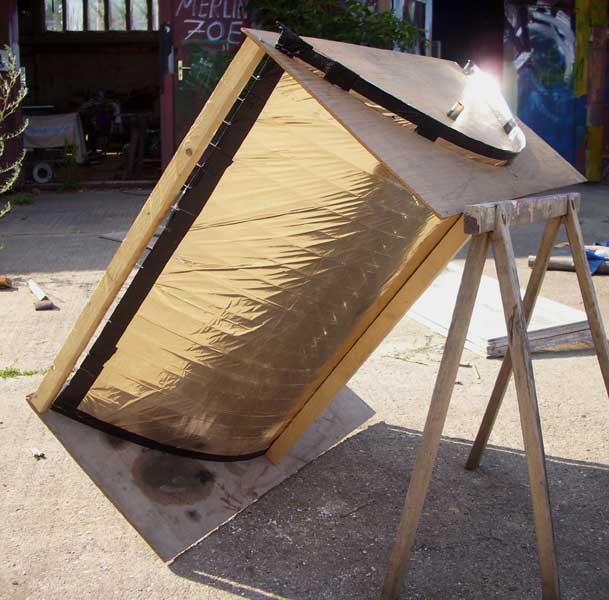Wolfram Alpha has just released a widget maker based on their computational knowledge engine, which for the geeks among us is pretty damn exciting.
Well...
I'm excited.
This one I made is for calculating solar noon for a given location, the time at which the sun is highest in the sky and vertical shadows run exactly north-south. This is very handy, as it's by far the easiest way to accurately aim your solar collector.
Saturday, 31 July 2010
Saturday, 10 July 2010
New wheel and gearing assembly.
Well, it's official. With the removal of the washing machine hose universal joint, opting instead to just tilt the whole gearing and attaching the collector directly to it, there is now not a single aspect of the device left from the original prototype I did in Australia.
Over the last year every single part of this thing has been replaced or heavily reworked, often four or five times over.
This is a mixed bag, emotionally.
As in the case of abandoning the 'bubbles rising against an immersed wheel' in favour of the current 'pumping liquid up to pour over wheel' which at a stroke removed two major construction issues but also made completely redundant at least two months hard work on getting the thing sealed.
The wheel is another example of this. As you can see in the video it's bidirectional, because up until a week ago resetting the device each morning required a whole seperate heat engine running the wheel, and thereby the collector, in the opposite direction. Now tho I'm working on a more simple and effective return mechanism involving a heat switch, which makes the bi-directionality of the wheel rather pointless. It was a lot of thought coming up with that design, rather than just mount the cans directly on to the shaft.
I'm going to keep it how it is, however, for three good reasons:
1) It's the same effort to make either way.
2) This design is a bit more efficient and avoids a problem with dead spots.
3)
And 4), I guess, it could be of use to someone who needs a really efficient, low revs high torque, bi-directional water wheel.
Collector improved.
 The first attempt was too wrinkly, and the tape used to pull the mylar tight was slipping a bit in the heat, so instead of pulling out points on the surface with the gaffer have instead lined the peripheries with bike spokes and flexible wire, pulling out the entire edge uniformly with cable ties.
The first attempt was too wrinkly, and the tape used to pull the mylar tight was slipping a bit in the heat, so instead of pulling out points on the surface with the gaffer have instead lined the peripheries with bike spokes and flexible wire, pulling out the entire edge uniformly with cable ties.I've also added two extra bits of wood lengthways to support the mesh, as it was bowling a bit in the middle.
This has the effect of making the thing pretty much perfect.
 I'm actually amazed how accurate the shape is, as you can see here; the focus is about 5mm wide, which is I imagine what you'd get from a professionally machine produced reflector.
I'm actually amazed how accurate the shape is, as you can see here; the focus is about 5mm wide, which is I imagine what you'd get from a professionally machine produced reflector.Just to reiterate that this has so far cost me about €10 in materials and can be whacked together in a couple of hours with a jigsaw and a drill.
I tested the balance and it's about 50 grams heavier on one corner, so two medium size bolts should bring it back to perfect, thereby having the thing require practically zero force to rotate.
Saturday, 3 July 2010
Main parabolic trough collector.
 So this is the main solar collector,
So this is the main solar collector,just shy of one kilowatt (one square meter). Worked out pretty easy to make; just some wood, an emergency thermal blanket and a sheet of wire mesh (and quite a bit of gaffer tape, tho the next version won't rely on that so heavily).
All up about €10 and two days work, tho most of that was figuring out how best to do it.
The hotspot is significantly tighter than I was realistically hoping, about 5mm from a 50cm aperture, or 100x magnification. And that's with it not really made quite as well as it could've been, a few surface deviations and wrinkles which don't need to be there.
Still needs a clear plastic sleeve for the copper pipe, but even without gets 300 ml water boiling in under ten minutes. Whole thing weighs about 6-8kg and if I've made it right should be pretty well counterbalanced, with the parabolic focus also being the center of gravity and rotation.
Subscribe to:
Comments (Atom)
